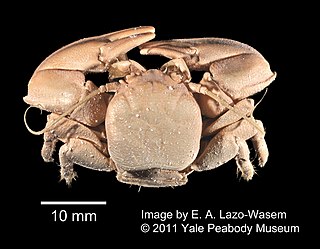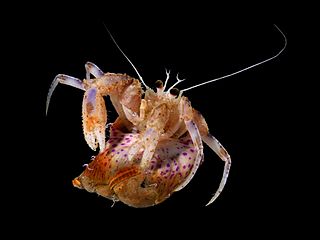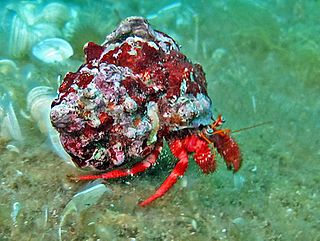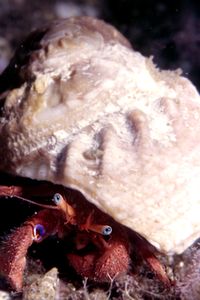
Hermit crabs are anomuran decapod crustaceans of the superfamily Paguroidea that have adapted to occupy empty scavenged mollusc shells to protect their fragile exoskeletons. There are over 800 species of hermit crab, most of which possess an asymmetric abdomen concealed by a snug-fitting shell. Hermit crabs' soft (non-calcified) abdominal exoskeleton means they must occupy shelter produced by other organisms or risk being defenseless.

Paguristes cadenati, the red reef hermit crab or scarlet hermit crab, is a small species of hermit crab with a bright red body and yellow eyestalks that lives in the Caribbean Sea. The specific name honours the French ichthyologist Jean Cadenat (1908-1992), who collected the type specimen and sent it to the French carcinologist Jacques Forest, who described it as a new species.

Pagurus longicarpus, the long-wristed hermit crab, is a common hermit crab found along the Atlantic and Gulf coasts of the United States and the Atlantic coast of Canada.

Pagurus novizealandiae, or the New Zealand hermit crab is a hermit crab of the family Paguridae, endemic to New Zealand. Its body is up to 16 millimetres (0.63 in) wide.

Sea anemones are a group of predatory marine invertebrates constituting the order Actiniaria. Because of their colourful appearance, they are named after the Anemone, a terrestrial flowering plant. Sea anemones are classified in the phylum Cnidaria, class Anthozoa, subclass Hexacorallia. As cnidarians, sea anemones are related to corals, jellyfish, tube-dwelling anemones, and Hydra. Unlike jellyfish, sea anemones do not have a medusa stage in their life cycle.

Diogenes pugilator is a species of hermit crab, sometimes called the small hermit crab or south-claw hermit crab. It is found from the coast of Angola to as far north as the North Sea, and eastwards through the Mediterranean Sea, Black Sea and Red Sea. Populations of D. pugilator may be kept in check by the predatory crab Liocarcinus depurator.

Vermicularia spirata, common name the West Indian worm-shell or the West Indian wormsnail, is a species of sea snail, a marine gastropod mollusc in the family Turritellidae. Juveniles can move around, but larger individuals become sessile.

Petrolisthes eriomerus is a species of marine porcelain crab found in the eastern Pacific Ocean. It is commonly known as the flattop crab. It is a flattened, rounded animal, with a carapace up to 20 mm (0.8 in) across. It is a filter feeder, and also sweeps food from rocks.

Pagurus prideaux is a species of hermit crab in the family Paguridae. It is found in shallow waters off the northwest coast of Europe and usually lives symbiotically with the sea anemone Adamsia palliata.

Lybia tessellata is a species of small crab in the family Xanthidae. It is found in shallow parts of the tropical Indo-Pacific Ocean. Like other members of the genus Lybia, it is commonly known as the pom-pom crab,cheerleader crab, or boxer crab because of its habit of carrying a sea anemone around in each of its claws, these resembling pom-poms or boxing gloves.

Libinia dubia, the longnose spider crab, is a species of crab in the family Epialtidae. It is found in shallow waters on the eastern coast of North America.

Dardanus venosus, the starry-eyed crab or stareye crab, is a species of hermit crab in the family Diogenidae. It occurs in shallow water on the eastern coasts of America from Florida southward to Brazil. It is sometimes kept in reef aquaria.

Calliactis tricolor, the tricolor anemone or hitchhiking anemone, is a species of sea anemone in the family Hormathiidae. It occurs in the Caribbean Sea and the Gulf of Mexico. It can be found attached to rocks but is often attached to a living crab or mollusc or an empty shell occupied by a hermit crab.

Loxorhynchus grandis, commonly known as the sheep crab or spider crab, is a species of crab in the family Epialtidae. It is the largest crab found on the California coast. The species was first described to science by William Stimpson in 1857. The type specimen was collected on the coast of California, near San Francisco. Fossils from the late Miocene epoch indicate that this species is at least 11.63 to 5.333 million years old.

Dardanus arrosor, the red reef hermit or Mediterranean hermit crab, is a species of hermit crab.

Paguristes eremita, the eye spot hermit crab, is a species of hermit crab in the family Diogenidae. It is found in the Mediterranean Sea.
Pagurus forbesii is a species of hermit crab in the family Paguridae. It is found in the northeastern Atlantic Ocean and the Mediterranean Sea.

Calcinus laevimanus is a species of hermit crab in the genus Calcinus found in the Indo-West Pacific region, the type locality being Hawaii.

Paguristes puncticeps is a hermit crab, in the family Diogenidae. It is found in shallow waters in the tropical western Atlantic Ocean, the Caribbean Sea and the Gulf of Mexico. Like other hermit crabs, it lives inside an empty mollusc shell, which it changes periodically as it grows.

Pycnogonum litorale is a marine arthropod in the family Pycnogonidae, the sea spiders. It is found in the northern Atlantic Ocean, the North Sea, the English Channel and the western Mediterranean Sea.




















